With several intriguing monikers, including the Peace Garden State, North Dakota is known for its scenic terrain where various wildlife roam. It also boasts many vibrant cities, a fascinating Native American culture, valuable natural resources (like sand, cement rock, and volcanic ash), and roughly 44.45 million acres. This vast land is handy for agricultural purposes, not to mention residential, commercial, and recreational undertakings. Knowing all this, you’re probably wondering; who’s in charge of the biggest tracts?
We did the homework for you. Here’s our round-up of the top four largest landowners in North Dakota. Keep reading to learn more about their properties and how they use them to benefit themselves, the locals, and visitors to this state bordering Canada.
1. Private Agricultural Investors – 38,548,498 Acres
As of December 2020, North Dakota had 38,548,498 acres of privately-held farmland; no wonder agriculture is the state’s largest sector. This industry accounts for a fourth of its employment, enabling thousands of individuals to work on various farms that produce a wide range of products, including:
- Honey
- Flax
- Field peas
- Canola
- Sunflowers
- Sugar beets
- Potatoes
North Dakota’s farmland is also home to many livestock. Statistics indicate the state had 1.95 million head of cattle and calves as of January 2021 — a 4% increase from January 2020, despite the COVID-19 pandemic.
While some of these animals boost the region’s beef production, others provide over 300 million pounds of milk to consume and process essentials like cheese, ice cream, yogurt, and butter. North Dakotan farmers also rear horses, swine, turkeys, sheep, chickens, and rabbits.
Ranches also sit on a considerable portion of North Dakota’s agricultural land. These are some of the most popular ones:
Bar X Ranch
Have you always wanted to explore the Badlands of North Dakota? Bar X Ranch is precisely where you should be. Nestled in Medora, this favored western-style ranch allows you to make unforgettable memories riding horses, camping, and hiking. If you’re a sucker for prairie dog hunting, you can indulge in it here free of charge! But first, you must get your varmint license from the North Dakota Game and Fish.
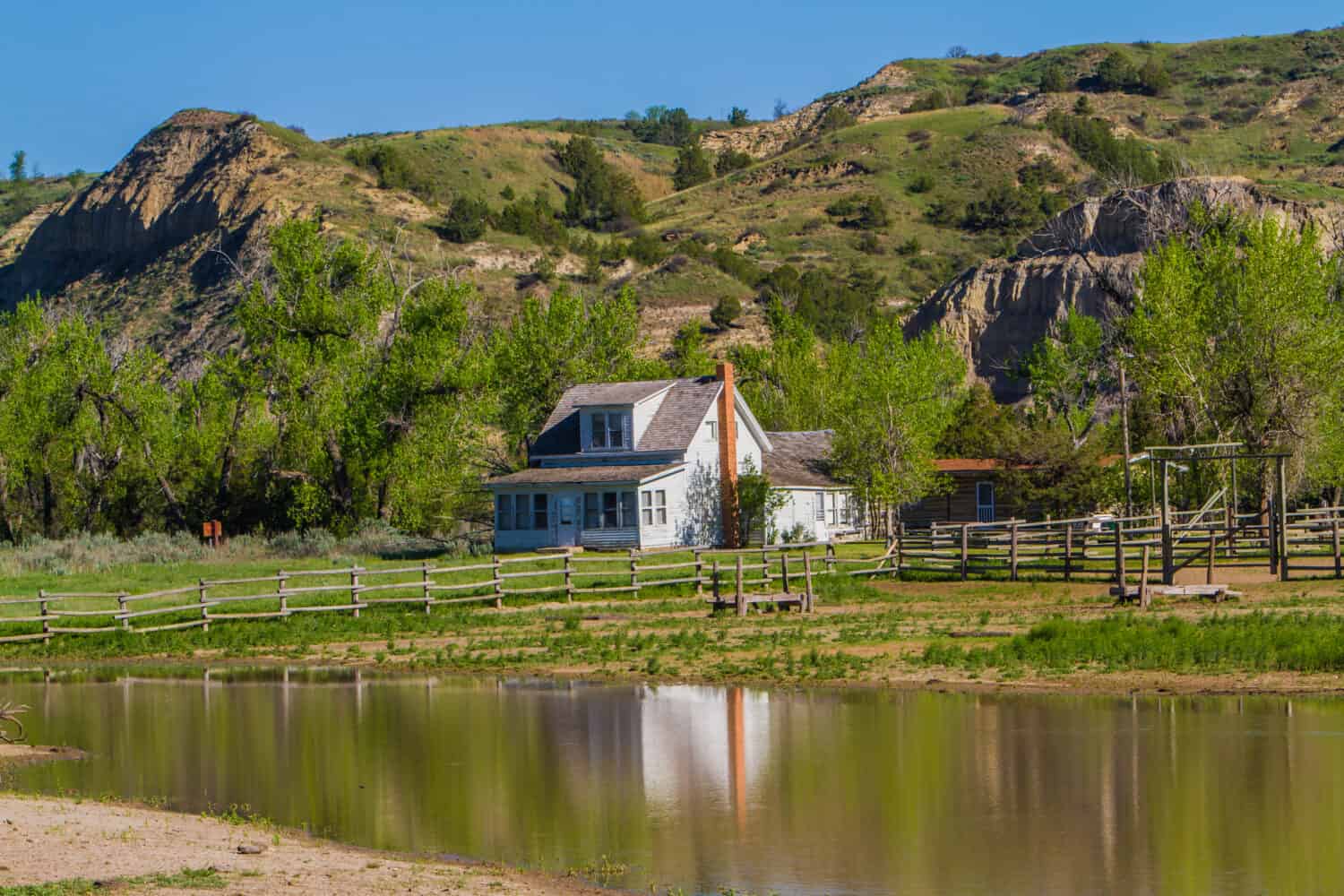
Bar X Ranch, nestled in Medora, is a favored western-style ranch that allows you to make unforgettable memories riding horses, camping, and hiking.
©Bob Pool/Shutterstock.com
Vollmer Angus Ranch Incorporated
Established by Alvin and Verna Vollmer in 1952, this family-owned and operated ranch is located in Wing, Burleigh County. It’s home to roughly 600 cows that graze freely on the vast prairie-covered land and some dogs. Additionally, it’s a popular location among Angus bull buyers looking for traits such as efficiency, deep bodies, and thick structures.
Oak Ridge Ranch
Here’s another family-owned and operated ranch on North Dakota’s vast farmland. Sitting on the west side of the state’s Turtle Mountains, Oak Ridge Ranch breeds horses and has cemented its place as the top go-to option for those looking for quality bloodlines. The Gustafson family, which has been in the horse breeding industry for over six decades, runs it.
Oak Ridge Ranch attracts those interested in learning about breeding, raising, and training equines. It also lures nature lovers who enjoy spectacular forest and prairie views.
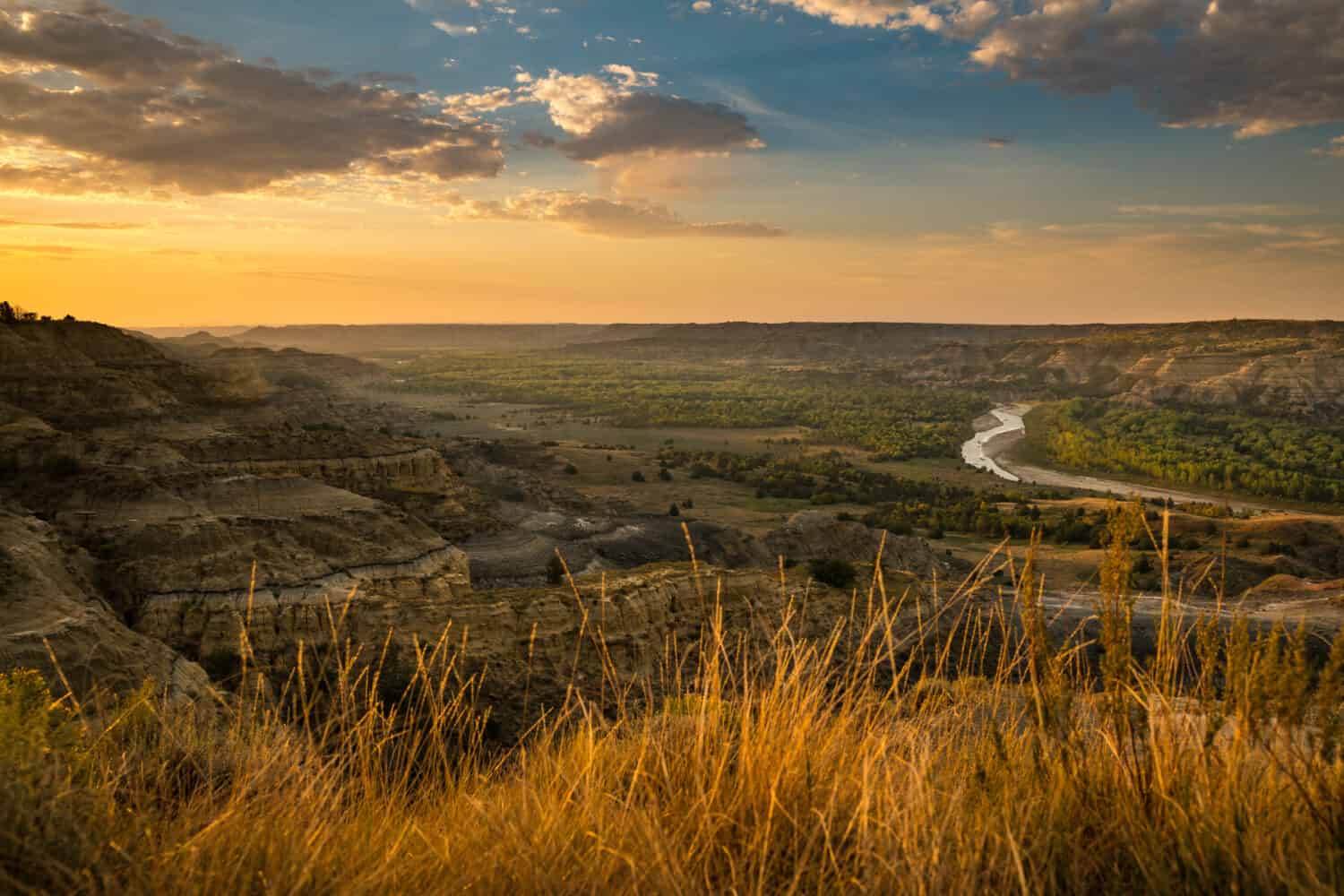
Oak Ridge Ranch is a family-owned ranch that breeds horses and has cemented its place as the top go-to option for those looking for quality bloodlines.
©TobyG/Shutterstock.com
Rust Mountain View Ranch
The Rust Mountain View Ranch is a Mercer-based farm that raises Angus and Simmental cattle, promising in-demand traits such as good feet, effortless calving, and perfect udders. It dates back to the 1940s when the passionate commercial ranchers and farmers, John and Violet Rust, established it. This thriving business is still in the Rust family and is operated by Jesse, Josh, and John EL, alongside their wives.
Sheldak Ranch
The legendary Sheldak Ranch has only been around since the 1960s. But it has built a solid reputation as one of the best Appaloosa horse breeders in North Dakota. Its owners, Dave and Kim Utke, are dead-set on providing superior bloodlines with:
- Endurance and strength
- Great looks
- Admirable disposition
- Trainability
- Intelligence
Potential buyers are advised to visit the ranch to check out the available weanlings, foals, stallions, and mares for sale.
2. North Dakota Department of Trust Lands – Over 2,600,000 Acres
The North Dakota Department of Trust Lands comes second on our list of top landowners in North Dakotas, as it administers more than 2,600,000 acres in the state. This body acquired most of this land through the Enabling Act, which Congress passed to allow for the division of the Dakota Territory in 1889.
The Enabling Act also provided land grants to support public institutions like colleges and universities in North Dakota. Today, the state department leases most of the land to earn revenue, allowing the lessees to use it for agricultural purposes, including cattle grazing.
North Dakotans are also free to hunt and fish on school trust lands. However, one must contact the lessees before their visit since they can limit access to protect their cattle.
3. Federal Government – 1,735,756 Acres
The federal government owns 27.1% of the United States’ 2.27 billion acres. In North Dakota, it’s in charge of 1,735,756 acres, only 3.90% of the state’s 44,452,480 total acres. The Peace Garden State is #31 on the list of U.S. states with the most federally-owned land, below South Dakota, Kentucky, Minnesota, Mississippi, North Carolina, West Virginia, and Vermont.
Here’s a breakdown of the government agencies managing North Dakota’s federal-owned land:
U.S. Forest Service (F.S.) – 1,106,034 Acres
With 1,106,034 acres of North Dakota land under its management, the Forest Service oversees five state forests and a memorial groove:
- Turtle Mountain State Forest
- Sheyenne River State Forest
- Homen State Forest
- Mouse River State Forest
- Tetrault Woods State Forest
- Nowesta Memorial Tree Grove
While these locations boast different features, they’re all meant to maximize North Dakotans’ recreational opportunities. Therefore, a trip to any of them will allow you to indulge in exhilarating pursuits like fishing, hiking, snowmobiling, hunting, camping, and cross-country skiing.
How the F.S. Maintain Forests in North Dakota
The Forest Service is tasked with maintaining the forests it oversees. That’s why the agency regularly conducts statewide surveys to determine the problems threatening these resources, such as pests. What’s more, it works hand in hand with foresters and other professionals to get rid of the complications.
Besides, the F.S. spearheads numerous campaigns to plant and care for trees all over North Dakota, contributing to the well-being of society. With the Outreach & Education Program, the agency increases awareness about the importance of forests and other natural resources to encourage citizens of all ages to preserve trees.

The Forest Service regularly conducts statewide surveys to determine the problems threatening these resources, such as pests.
©Impassioned Images/Shutterstock.com
Additionally, the F.S. runs the NDFS Fire Management Program, which helps to protect natural resources, people, and property if there’s a wildfire. Unfortunately, these tragedies are common in the state. Between January and June 2021, 1,400 fires engulfed over 100,000 acres statewide. Sadly, humans caused most of them, which means they were avoidable.
U.S. Fish and Wildlife Service – 484,681 Acres
Like other states nationwide, the U.S. Fish and Wildlife Service aims to protect and enhance wildlife (including fish), plants, and their habitats. This agency now owns 484,681 acres in North Dakota and runs the Ecological Services Field Office – which collaborates with other state and federal agencies – to achieve that feat.
The North Dakota Ecological Services Field Office has various programs tailored toward conserving these endangered species:
- Whooping crane
- Dakota skipper
- Pallid sturgeon
- Black-footed ferret
- Poweshiek skipperling
- Western prairie fringed orchid
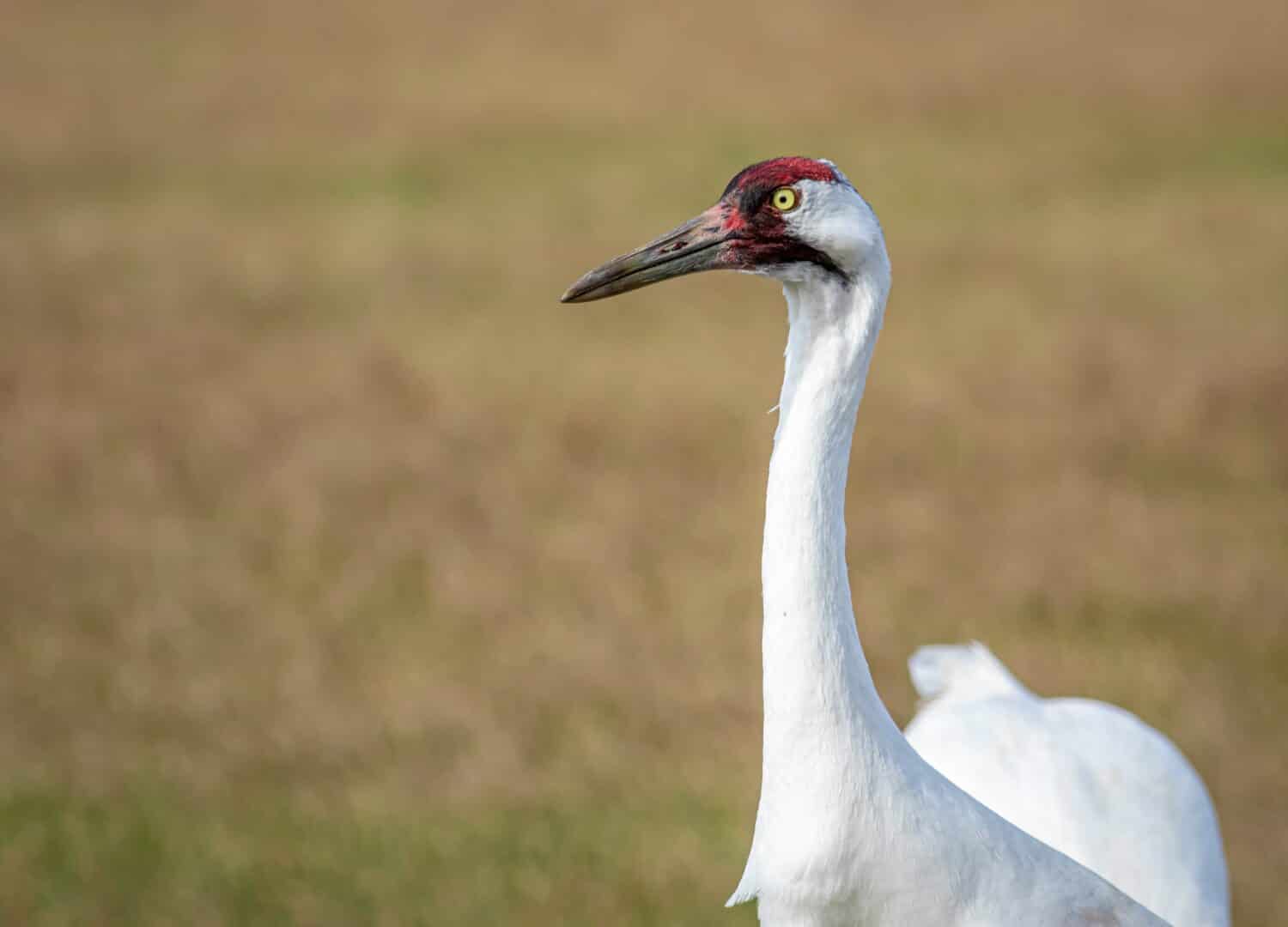
The whooping crane is among the endangered species the North Dakota Ecological Services is tasked to conserve.
©Matthew Jolley/Shutterstock.com
U.S. National Park Service (NPS) – 71,250 Acres
The U.S. National Park Service’s mission is to preserve the nation’s natural and cultural resources for Americans’ enjoyment, inspiration, and education. As of this writing, it controls 71,250 acres in North Dakota. The land hosts the following five thrilling destinations for locals and tourists:
Theodore Roosevelt National Park
Nestled in western North Dakota, the Theodore Roosevelt National Park honors the United States’ youngest president, Theodore Roosevelt. After President William McKinley’s assassination, he rose to power when he was barely 43 but still achieved some notable feats. For instance, he relentlessly advocated the conservation of natural resources and avoided labor strikes.
The Theodore Roosevelt National Park is home to many wildlife, including prairie dogs, elk, bison, deer, feral horses, pronghorn, and reptiles such as snakes and lizards. If you’re a plant enthusiast, you might also be fascinated by the countless plant species available at this location, including the following native flora:
- Oregon woodsia
- Ponderosa pine
- Dense spikemoss
- Creeping juniper
- Brittle bladder fern
- Rocky Mountain juniper
- Smooth scoring rush
- Field horsetail
- White sweet clover
Fortunately, this national park allows you to explore it with your furry friend. Although it has no cafes, cabins, or hotels, you can easily find food and accommodation within the nearby areas. More activities to indulge yourself and your family here include hiking, camping, and star viewing.
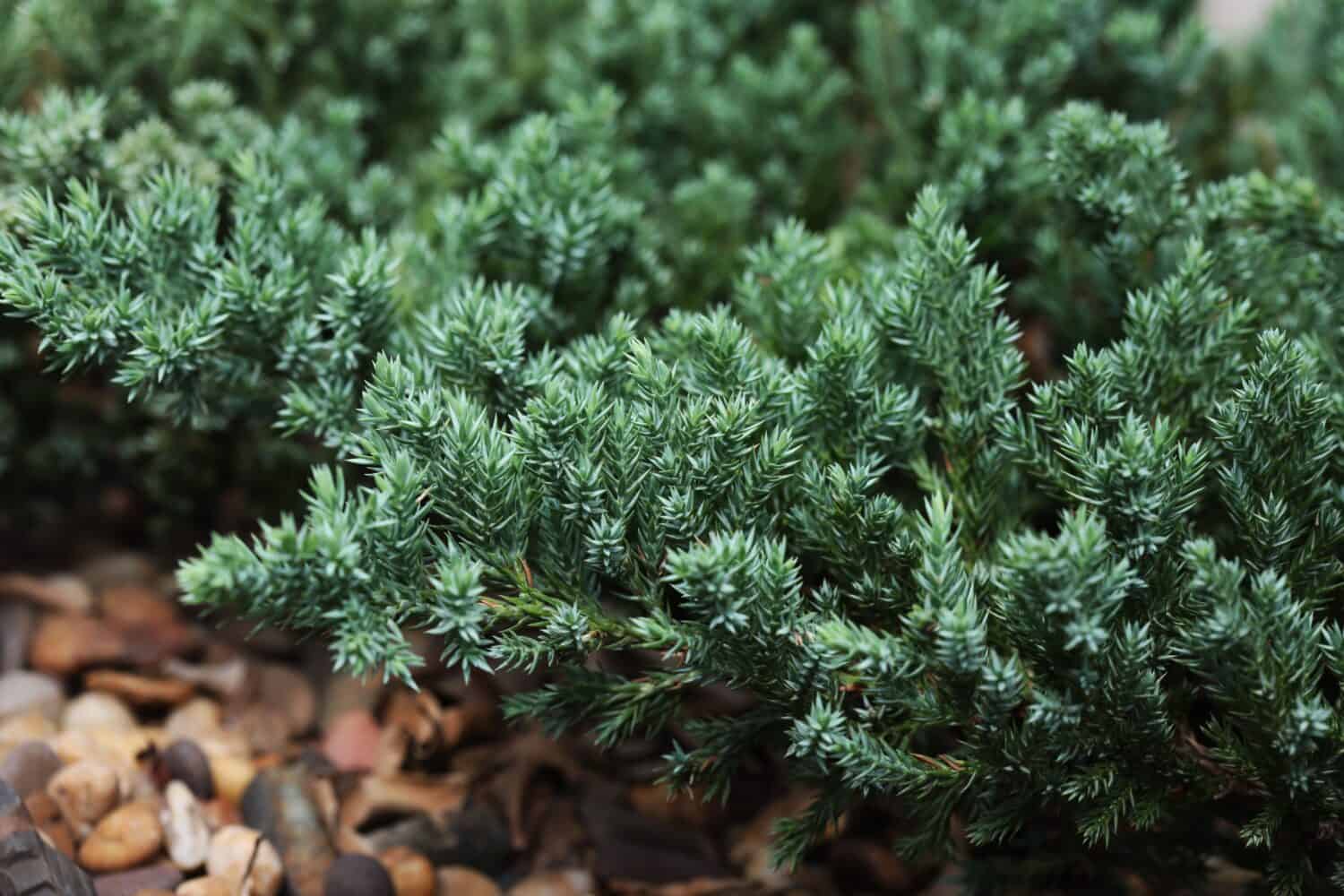
If you’re a plant enthusiast, you might also be fascinated by the countless plant species available at Theodore Roosevelt National Park, including the creeping juniper.
©Pavaphon Supanantananont/Shutterstock.com
North Country National Scenic Trail
Stretching roughly 4,800 miles, the North Country National Scenic Trail is also under the National Park Service’s management. It traverses over 150 public lands, including game areas, forests, and parks, in up to eight states, including North Dakota, New York, Vermont, Ohio, Minnesota, Wisconsin, and Pennsylvania.
The North Country National Scenic Trail is most popular among enthusiastic hikers. Given that it connects diverse landscapes, including bustling cities and magnificent valleys, there’s so much for these adventurers to discover.
Lewis & Clark National Historic Trail
Here’s another trail the National Park Service oversees. Covering 4,900 miles, it’s even longer than the North Country National Scenic Trail. Moreover, it passes through over sixty tribal nations in more than sixteen states, such as North Dakota, South Dakota, Montana, West Virginia, Ohio, Iowa, Nebraska, Oregon, Washington, and Missouri.
Typically, most enthusiastic hikers take 3-4 weeks to travel the entire Lewis & Clark National Historic Trail. But you could take less or more time, depending on your travel mode, enthusiasm, and other activities you indulge in. Exploring the cities and towns along the route will require more time to complete your long hike.
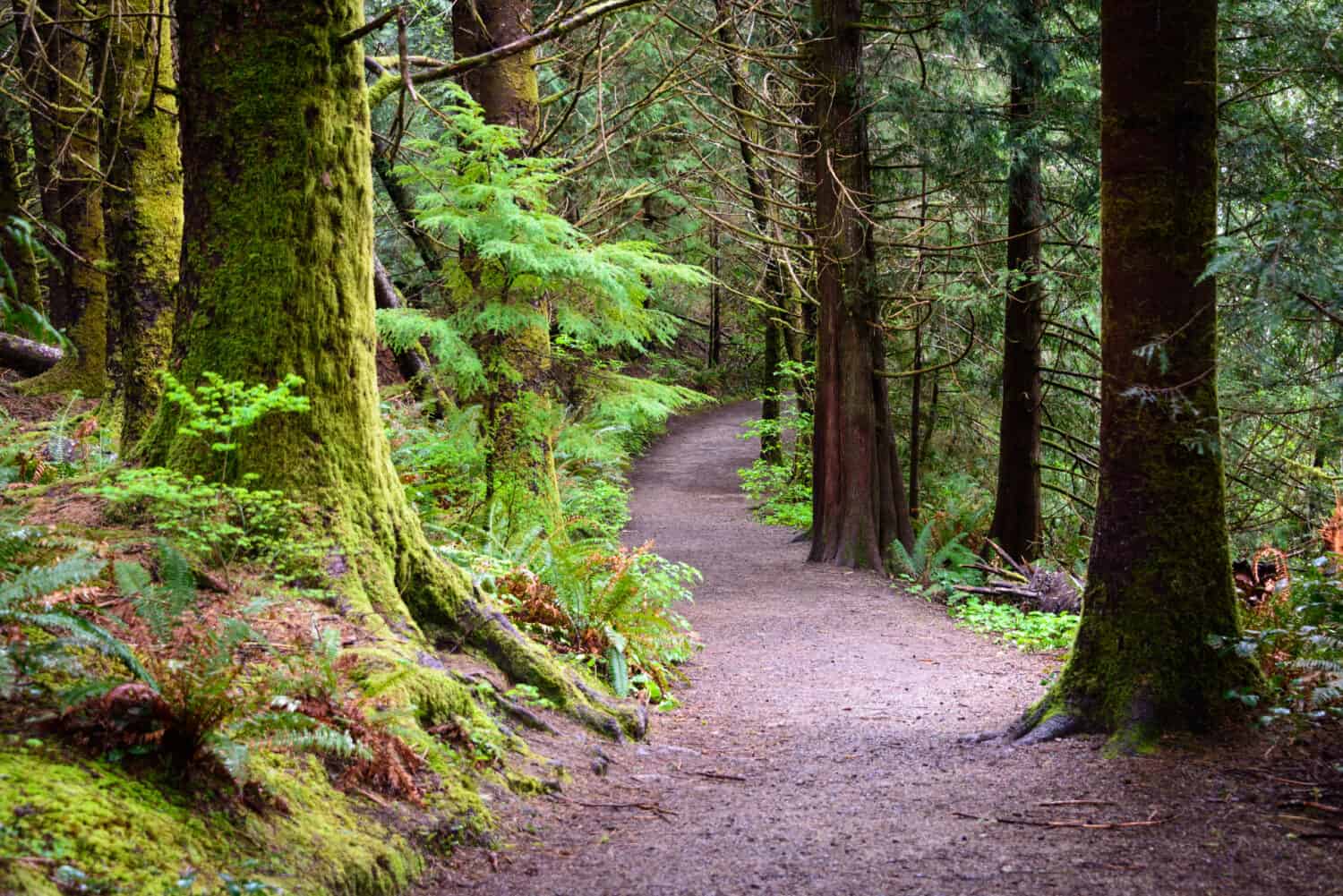
©Zack Frank/Shutterstock.com
Fort Union Trading Post National Historic Site
The NPS is also in charge of Williston’s grand Fort Union Trading Post, an important location for traders between 1828 and 1867. About seven Northern Plains Tribes, including the Assiniboine, assembled here to exchange a plethora of items, such as blankets, clothes, beads, and guns.
Today, this destination welcomes history fanatics ready to explore it and learn about what transpired at various spots centuries ago. Fortunately, it’s open all year round, and your loved ones – pets and kids aged at least 5 – can tag along.
Knife River Indian Villages
If Native American history fascinates you, create time to visit this historical site that the NPS administers. This historic site, which has been around since 1974, hosts archeological remnants of the Hidatsa, Siouan people who inhabited Upper Missouri for centuries. Expect to see their abandoned earth-lodge dwellings here.
Other things to find at the Knife River Indian Villages include:
- Plants: Wild plums, Juneberry, choke cherry, prairies, and buffalo berry.
- Animals: Coyotes, beavers, skunks, squirrels, Canada geese, turkeys, red-tailed hawks, pheasants, and kestrels.
- Insects: Bugs, beetles, bees, wasps, ants, and leaf hoppers.

The Knife River Indian Villages, which has been around since 1974, hosts archeological remnants of the Hidatsa, Siouan people who inhabited Upper Missouri for centuries.
©Traveller70/Shutterstock.com
U.S. Bureau of Land Management – 58,841 Acres
The U.S. Bureau of Land Management has secured 58,841 acres in North Dakota but governs a whopping 247.3 million acres nationwide. This government agency was established in 1946, and its primary objective is to administer federal lands to aid the following:
- Energy production.
- Mineral development.
- Livestock grazing.
- Provision of recreational facilities.
U.S. Department of Defense (DoD) – 14,950 Acres
The DoD only owns 14,950 acres in North Dakota. This department may own the least acreage in the state, but it’s still the largest US government agency, with nearly 30 million acres.
The DoD has about 1.3 million individuals on active duty in the United States. These are mainly Army, Navy, Air Force, or Marine Corps members. They all work together to guarantee the safety of all Americans, including North Dakotans.
4. Foreign Agricultural Investors – 314,626 Acres
As of December 2020, North Dakota had 314,626 acres of foreign-held agricultural land. It’s easy to grasp why investors from other countries acquired land in this state.
North Dakota is cheap, meaning essentials like food and housing are affordable. Besides, most cities here boast low crime rates, making it unnecessary to constantly look over your shoulder or refrain from stepping out at night. Moreover, Peace Garden State has low crime rates, many employment opportunities, and better air quality, making it a good place to live.
Unfortunately, if you want to buy land here as a foreigner, you no longer stand a chance. The Legislature recently passed SB 2371, which prohibits outsiders from acquiring real estate property in the state. Because this bill doesn’t cover inherited land, you can still own a plot if a loved one gives you ownership.
Become a Landowner in North Dakota
Are you looking to join the coveted league of landowners in North Dakota? It’s super easy! Start by scouring the market for a piece that suits your interests. For instance, if you’re hoping to farm, consider the land’s fertility, climate, and topography, depending on the crops you’re interested in.
Then, hire a trustworthy real estate agent to guide you through the land-buying process and provide handy details to guarantee a safe and successful purchase. You should also work with a qualified local attorney when buying land in North Dakota. They grasp the legal framework and can help you understand it before signing any binding documents.
Summary of The 4 Largest Land Owners In North Dakota
Here are The 4 Largest Land Owners In North Dakota:
| Rank | Land Owners | Acres |
|---|---|---|
| 1 | Private Agricultural Investors | 38,548,498 Acres |
| 2 | North Dakota Department of Trust Lands | Over 2,600,000 Acres |
| 3 | Federal Government | 1,735,756 Acres |
| 4 | Foreign Agricultural Investors | 314,626 Acres |
The photo featured at the top of this post is © Jacob Boomsma/Shutterstock.com
Thank you for reading! Have some feedback for us? Contact the AZ Animals editorial team.







